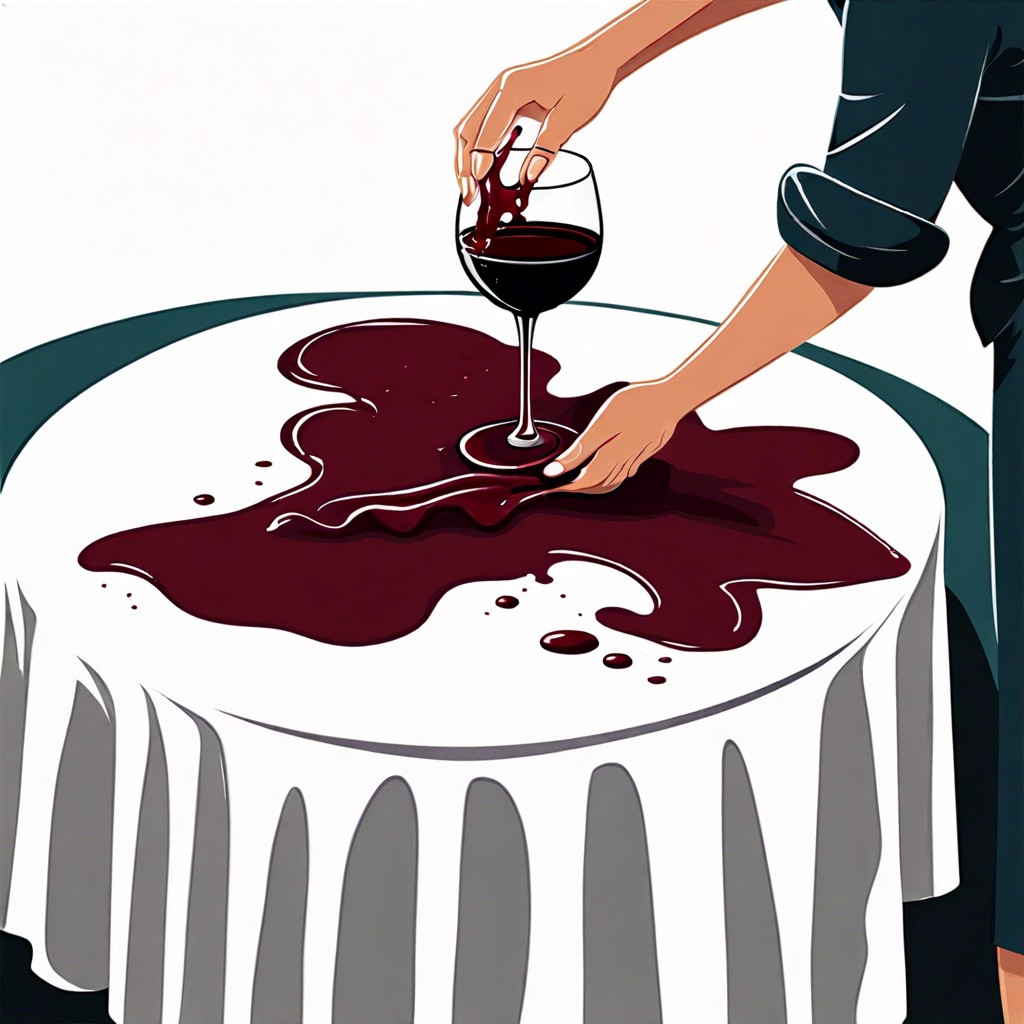Last updated on
Learn practical steps for effectively removing red wine stains from furniture to restore your pieces to their original splendor.
Key takeaways:
- Act quickly to prevent the wine from setting into the fabric.
- Blot the stain gently with a clean cloth, avoiding rubbing.
- Use salt and soda to absorb and remove the stain.
- Utilize white vinegar to break down the stain’s color pigments.
- Follow proper steps for removing red wine stains from washable fabrics.
Table of Contents
Act Quickly

Time is of the essence when dealing with spills. The sooner you address the blemish, the less chance it has to penetrate the fibers deeply. Begin the cleanup process immediately upon noticing the spill to prevent the wine from drying and setting into the fabric.
Use a clean, absorbent cloth to gently dab the stain. This helps absorb as much liquid as possible without spreading the wine further. Avoid rubbing at all costs, as this can work the wine deeper into the material, making it more challenging to remove.
Remember that patience is key. Continue blotting with a fresh section of the cloth until no more wine transfers to the cloth. This initial step can significantly reduce the stain’s prominence, improving the effectiveness of subsequent cleaning methods.
Preparation matters. Keep in mind that efficient cleaning also requires having the right materials at hand, so consider having a quick-response cleaning kit available at all times if red wine is a frequent guest in your home.
Blot, Don’t Rub
When confronted with a red wine spill, your instinct might urge you to rub the area in an attempt to get rid of the stain. However, this common mistake can actually worsen the situation by spreading the stain and pushing the wine deeper into the fabric. Instead, take a clean, absorbent cloth or paper towel and press it gently against the spill. The goal is to soak up as much liquid as possible by allowing the cloth to absorb the wine, which helps prevent it from setting into the material. Patting the stained area from the outside towards the center can also minimize the spreading. Keep using fresh sections of the cloth or new paper towels until no more wine transfers to the fabric. This method is crucial in preparing the stain for further cleaning treatments, as it prevents it from becoming more ingrained in the fibers of the fabric.
The Salt and Soda Trick
Upon discovering a red wine spill, immediately sprinkle a generous amount of salt over the affected area. The salt serves to absorb the liquid, drawing out the pigments from the fibers. Let the salt sit and work its magic for a few minutes; depending on the spill’s size, this can range from three to five minutes. During this time, the salt may turn pink as it picks up the wine.
Next, vacuum up the salt or scoop it away carefully, ensuring not to spread the stain further. Follow up by mixing a solution of baking soda and water to create a paste-like consistency. Apply this mixture to the stain, gently covering it completely. Baking soda acts as a mild abrasive and a natural deodorizer, tackling both the stain and any potential odor.
Allow the paste to dry, which usually takes about an hour. As the paste dries, it continues to lift the stain from the material. Once completely dry, vacuum up the residue. This method is often effective for absorbing and removing the discoloration caused by red wine, leaving your furniture looking untouched by the accidental spill.
The White Vinegar Trick
White vinegar is an excellent natural cleaner that can help lift red wine stains due to its acidity. What it does is break down the wine’s color pigments, making it easier to remove the stain from your furniture’s fabric. Here’s how to utilize white vinegar effectively:
- Create a solution of one tablespoon of white vinegar and one tablespoon of liquid dish soap in two cups of warm water.
- Dip a clean cloth into the solution and gently apply it to the stained area, ensuring you don’t soak the fabric.
- Use a dry cloth to blot the area, observing as the stain begins to transfer from your furniture to the cloth.
- Repeat the process with the vinegar solution and the dry cloth until the stain is no longer visible.
- Rinse the area by blotting with a cloth dampened with cold water to remove any residue from the cleaning solution.
Remember, it’s imperative to test the vinegar solution on an inconspicuous area of your furniture first to ensure that it doesn’t cause any discoloration or damage.
For Washables
When dealing with fabrics that are machine washable, the approach to red wine stains needs to embrace patience and precision:
- Pre-Treatment: Gently apply a stain remover or liquid laundry detergent to the stained area and let it sit for a few minutes. Enzymatic cleaners are particularly effective as they break down the stain molecules.
- Cool Water Rinse: Flush the affected area with cool water. Warm or hot water can set the stain further, so stick to a cold rinse which helps to lift out the wine.
- Wash as Usual: Place the garment in the washing machine on a normal cycle with similar colors. Ensure you use the appropriate detergent for the fabric type.
- Check Before Drying: After washing, inspect the stain before placing the garment in a dryer. The high heat from the dryer can make the stain permanent if it’s not fully removed.
- Repeat if Necessary: If the stain persists after the initial wash, repeat the pre-treatment and washing process. Avoid drying until the stain is completely gone.
In leveraging these steps, your key to success will be persistence and avoiding heat until the stain is no longer visible. Remember, even the most daunting red wine stains can be conquered with the right washable fabrics game plan.




